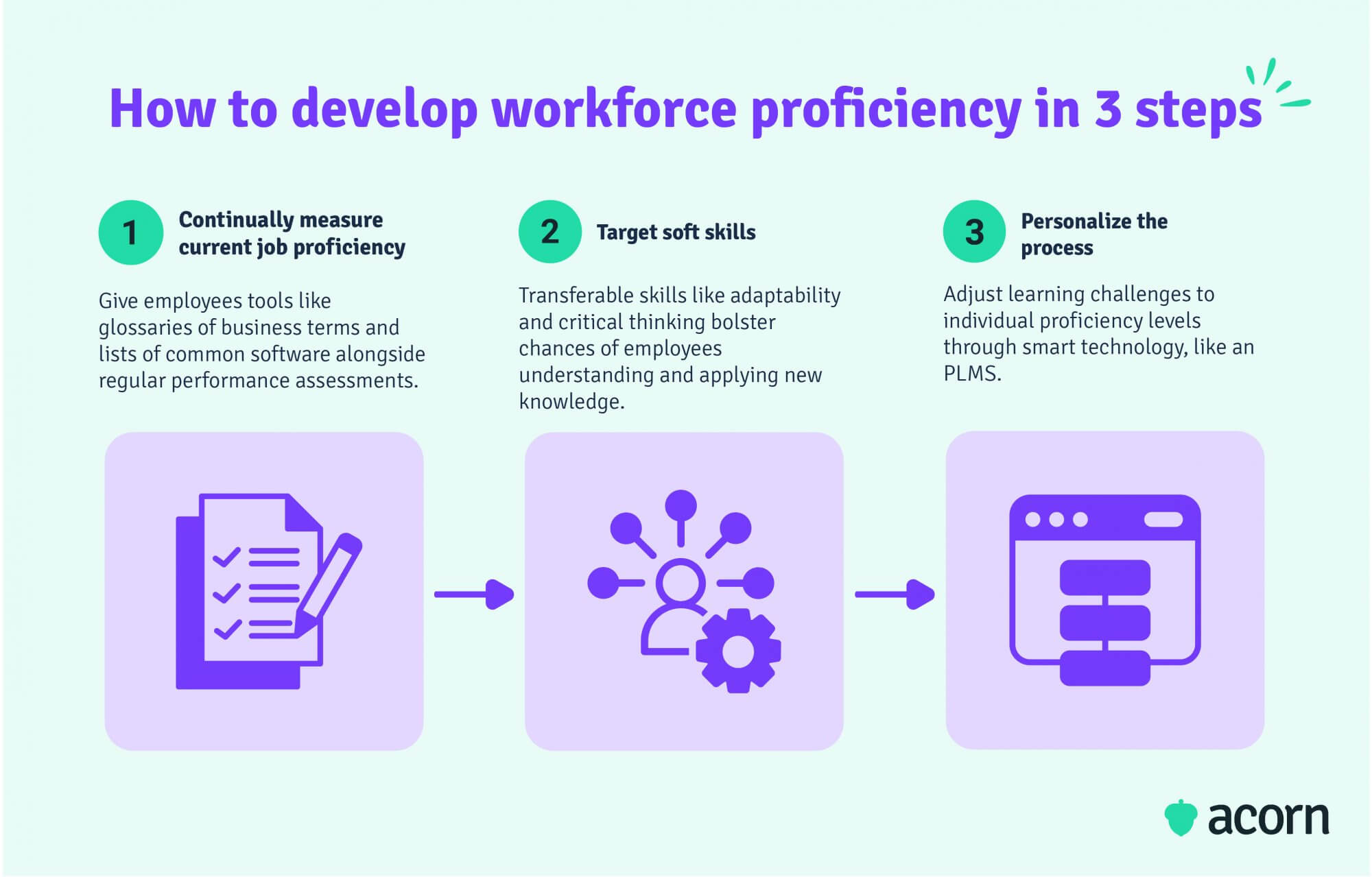Why Does Proficiency Matter to the Success of Your Business?
Reading Time:

Lead the pack with the latest in strategic L&D every month— straight to your inbox.
SubscribePractice makes perfect, they say. We say they’re not wrong, but with an amendment or two. Practice makes proficient employees, and proficient employees make for a successful business.
This is because proficiency underpins performance for employees and capabilities for business by giving a measure of growth, skills, behaviours, and knowledge that leads to success.
Here, we’ll talk about the importance of proficiency in business, the difference between proficiency and performance (hint: they’re complementary) and how to better develop it in your organisation.
What is proficiency?
Job proficiency refers to an advancing level of skill and knowledge in a certain field. While someone who is proficient is usually considered highly skilled or knowledgeable, proficiency itself can be a sliding scale of competence when developing a skill, attribute or knowledge.
The difference between performance and proficiency
There exists a school of thought that “proficiency” exists solely and ubiquitously in the real world, while “performance” is something that is only ever measured during assessments or for achievement. In this way, performance is measured in controlled circumstances, like flexing a certain leg muscle during a gym session. Proficiency is the act of using a skill at any time, like using said muscle while you’re simply walking around.
In the workplace, we can look at proficiency as a way of understanding employees’ day-to-day performance. Knowing if they are proficient in X, Y and Z capabilities gives you a better foundation for understanding:
- The strengths and weaknesses your organisation possesses (at a high level); and
- The capability gaps that training can plug (at an individual level).
Proficiency is then the crux of employee training or the desired end state of a test of performance, so to speak. Both proficiency and performance have their place, but let’s dive deeper into the importance of the former in the workplace.
Why is it important to define and refine proficiency?
You likely have learning and development programs. These need to have a purpose, lest they be just another little-loved corporate initiative. One way to garner enthusiasm for your L&D pathways is to create personal learning goals for each employee. Again, these need a purpose. A goal can’t just be “complete X course”. You need outcomes.
Outcomes in turn should be linked to business goals. Say you have a leadership development program for the bright-eyed amongst your workforce. There will be certain behaviours expected of emerging leaders, e.g., emotional intelligence, trust, delegation. Ergo, you have expected outcomes right there. And the handy thing about outcomes rooted in business language and credo is that they can be continually assessed and measured beyond the end of a course.
A large part of the problem is that many learning solutions don’t make the link between learning and business outcomes. This is why we pioneered the performance learning management system (PLMS), the only solution that guides learners through step-by-step pathways to master the capabilities needed to accelerate their and your organisation’s performance.
And this is where proficiency comes in, specifically on two fronts:
- Efficiently hiring the right people
- Ensuring employees are always performing.
Efficient recruitment
Sifting through dozens of resumes and sitting in just as many interviews wastes time and relies on the unavoidable bias of the person conducting either task. If a position requires specific skills, knowledge and behaviours, standards help streamline the recruitment process.
Defined job proficiencies enable:
- Mini assessments to shed light on a candidate’s niche skillset in a standardised way. Think writing tasks for communications roles, coding tests for developers.
- Standardised criteria for recruiters and HR to use in interviews. This helps make culture-based choices as much as meeting performance expectations. Behaviours can be difficult to divine on the spot—even when crucial to a role—making a ready-made description handy when assessing candidates.
Performance evaluation
Very few enjoy the performance review. But proficiency-based performance management ties behaviours to successful goal execution, enabling real-time course correction.
Say you’ve got an individual in Finance whose initial budget analysis wasn’t quite right, delaying a project. Instead of just saying, “You’re not hitting the mark” (not helpful, mildly accusatory), proficiencies enable managers to quantify it. Linking the quota to capabilities like Management Accounting means you’re not just judging on something that may not be that useful a marker, such as substantial math proficiency (though important). This further gives both employee and manager grounds for understanding what effective performance is and where capability gaps may exist.
What are the benefits of more proficient employees?
There are market forces beyond your control that can affect your organisation’s standing. The way to weather the storm of market volatility (or avoid it entirely) is to ensure your workforce has the expertise that drives your competitive edge, and what powers expertise is proficiency.
If we’re talking specifics, proficient employees give you the advantage of:
- Maximised productivity
- Optimised resources
- Improved ROI.
Maximised productivity
Proficient employees are more likely experts at their jobs than not. At the very least, they’re efficient workers. This largely comes down to experts having little need for trial-and-error. A proficient individual can confidently (and often, experientially) say why something would or wouldn’t work, which saves their team time, money and duplicate work. It’s something not unlike an artist’s distinctive technique; consider the difference in skills between a graphic designer and a UI designer.
Optimised resources
One lacking employee can really bring a project to a halt. Consider a time you worked with someone who was new and needed training, or perhaps even someone who just needed a lot of help to get their work done. It takes you away from your own tasks and draws out the amount of time spent on theirs, too.
On the other hand, an individual of great facility knows the scope of their abilities and can better delegate areas of weakness to other employees—or even more sophisticated software. (That means you’re enjoying the benefits of not only proficiency, but efficiency too.)
Increased profitability
A handful of highly skilled employees are more likely to deliver the results you want than dozens of workers who have, let’s say, a tolerable proficiency. (Quality over quantity always wins out.) The smarter you are with staffing, the shrewder you can be with resourcing and budgeting. And when it comes time to innovate, both the added padding on your budget and expertise from proficient employees will help drive your business success.
Developing employee proficiency
It can be easy to recognise high proficiency in a high-performer, but harder to narrow down how a high-performer develops it. When that job is highly specialised, it can be difficult for new employees to attain proficiency without training. And when employees get off to a bad start, it means:
- Their self-confidence begins to wane
- Employee engagement decreases while mistakes can increase
- Worst case, they start to consider moving elsewhere.
Faster time to proficiency has a financial and competitive edge. While an organisation’s proficiency levels usually remain stable (especially if connected to business-critical tools like a capability framework), the rate to becoming proficient can differ between individuals. Developing employee proficiency at a faster rate means you’re developing time to expertise at a faster rate—and that’s truly where your organisation gains value, customer satisfaction and overall effectiveness.
And since proficiency measures competence, knowledge and skills—and competence, knowledge and skills are developed through theory and practice—it follows you can develop it.

Measure job proficiency
If you’re starting from scratch, it often helps to look at your onboarding employees. Gaps can be found through entrance tests that assess key job-related knowledge and skills. More examples for use throughout the employee lifecycle include:
- Self-assessments. These can be provisioned throughout an employee’s career to ascertain how they feel about their own skills.
- Routine performance reviews. One-on-one chats between managers and team members gives both a chance to re-evaluate parameters for demonstrating competency.
- Specific work assignments. Gradually offering more responsibility and evaluating how employees manage can help assess expanding proficiency.
Provide tools for proficiency
Go digital, is what we’re saying. We’re not stone age humans anymore, so ditch the paper packs. New employees often need to internalise a lot of information and acclimatise to a foreign business language. Providing a glossary of terms, acronyms and just commonly used phrases within your organisation or industry can help bring new hires up to speed much quicker. This can be in a central place, like your onboarding portal or learning management system.
Target soft skills
Most people know that soft skills are just as important as hard skills these days, but they are still criminally underdeveloped. And by that we mean often not developed. Soft skills are big players in recruitment (“active listening comprehension”, “strong time management”), but often not considered a trainable offense outside of leadership development.
Yet soft skills like critical thinking, adaptability and, yes, effective communication can support an employee’s ability to learn hard skills. Think about it: People have to be willing to change for a development program to be effective. If people aren’t adaptable, they can’t change. And if they can’t change, there’s no accumulating the proficiencies needed in your mission-critical technical skills and capabilities.
Personalise the process
If we’ve said it once, we’ve said it a million times by now: Personalising learning is the best way to get and keep employees invested (and get your return on investment). Personalisation works to boost skills proficiency in a couple of key ways:
- Learning in the flow of work combines performance and proficiency perfectly. It gives employees a chance to see the real-world implications for learnings, but also ensures they still get timely feedback when they make a misstep.
- Adaptive learning is a step up from personalised learning, bringing technology into the fold. It adjusts learning pathways to accommodate pace, preferences and capabilities, meaning that challenging subject matter is only ever matched to individual’s current level of proficiency.
Key takeaways
It’s not just our word of the day. Job proficiency is about ensuring employees are proficient in certain skills and knowledge to a level that supports your business goals. (So, save this word in your L&D vocab.)
Defining proficiencies in a manner that aligns with your organisational objectives enables you to more efficiently hire the right people and evaluate performance effectively. And when employees are up to scratch… ahem, proficiency… it gives you the benefit of maximised productivity, optimised use of resources and increased profitability.
Practice greatly improves proficiency. Developing very considerable proficiency amongst employees starts with assessing where they’re currently at (again and again), providing tools for upskilling, targeting their soft skills in order to develop hard ones and personalising the learning process to their specific skills gaps. All in all, it helps ensure your employees are high performers and your organisation’s business structure is actually leading to success.